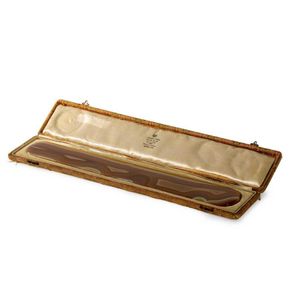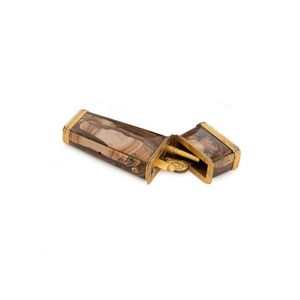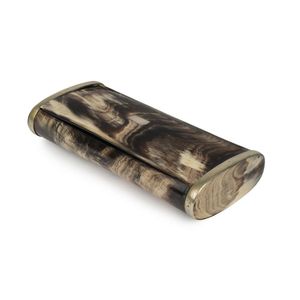Georgian Horn and Metal Snuff Box with Silver Plaque
You must be a subscriber, and be logged in to view price and dealer details.
Subscribe Now to view actual auction price for this item
When you subscribe, you have the option of setting the currency in which to display prices to $Au, $US, $NZ or Stg.
- Horn - Full horns were used for making drinking vessels and powder horns. A number of larger horns or antlers could be combined together to make furniture and decorative items such as chairs and lamps.
As a material, horn was formerly used in all types of objects such as snuff boxes, lanterns, musical instruments, items for personal grooming, cutlery handles, walking sticks. Some items of horn are finely decorated with silver or mounted in silver. - Circa - A Latin term meaning 'about', often used in the antique trade to give an approximate date for the piece, usually considered to be five years on either side of the circa year. Thus, circa 1900 means the piece was made about 1900, probably between 1895 and 1905. The expression is sometimes abbreviated to c.1900.
- Georgian - As an English stylistic period, Georgian is usually taken to cover the period from George I (1714) to the Regency of Prince George (1811-20), although the period from 1800 to 1830 is sometimes designated as the Regency period. During the Georgian period the great English cabinetmakers and designers such as Chippendale, Hepplewhite, Adam Sheraton etc., were all active.
Therefore there isn't a single 'Georgian style' as such and to say something is 'Georgian', usually means it was made between 1714 and 1830. This assumes we discount George V and George VI, both being from the 20th century.
The styles popular at the time of each reign were:
George I (1714-1727) saw out the last years of the Baroque period.
George II (1727-1760) reigned during the Rococo period.
George III (1760-1820) saw the last gasp of the Rococo, all of the early Neo-Classic 'Adam style' and most of the later neo-Classic 'Regency style'.
George IV (Prince Regent 1820-1830)encompassed the last of the 'Regency' style.
William IV's reign (1830-1837) was something of a no man's land (stylistically) and he wasn't a 'George' anyway. He covered the last glimmerings of 'Regency' and the start of the 'Victorian' style.
This item has been included into following indexes:
Visually similar items

A Victorian gilt mounted facetted clear glass vinaigrette/scent bottle, circa 1880 by Sampson Mordan & Co with floral embossed ends, 10 cm long

An agate paper knife, in fitted box, retailed by Auguste Feys, French, circa 1920, 35 cm long. Provenance: Mossgreen, Quarterly Collectors Auction Series, Melbourne, 2016, lot 81

A mocha agate etui, French, early 19th century. 9 cm long

A double ended ruby glass scent bottle with silver caps, 19th century. 12 cm
